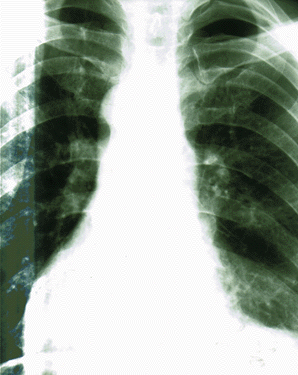PneumothoraxStrange medical condition afflicts tall, thin peopleBy Wayne Leung Tall, thin figures are usually subjects of admiration in society. However, a medical condition called pneumothorax is found in lanky people at rates higher than in the general population. Dr. Chiu Shiu-wah is the chief of service in the Division of Cardiothoracics at Grantham Hospital.
X-rays are used to diagnose the medical condition known as pneumothorax.Said he: “The condition is often found in tall, thin young adults aged 20 to 30. “It occurs when the air sacs on top of the lung are broken. Air is collected in the patient’s chest, causing the lungs to collapse. “It may also happen when the walls of the lungs are weakened.” However, Dr. Chiu said that the causes of the condition are not known. Also, more males suffer from it than females, for unknown reasons. No symptom is detected before the condition sets in. When pneumothorax occurs, patients have a sudden, sharp chest pain accompanied by shortness of breath. “However, there is no prevention measures before it occurs,” added Dr. Chiu. Mr. Yip Sin-chuen, aged 20, a university student, first suffered from pneumothorax when he was 18. “It came on suddenly while I was playing computer games at home,” said Mr. Yip. “Suddenly, my chest hurt and I had difficulty breathing. It lasted for almost 45 minutes. I rushed to the hospital immediately.” Mr. Johnny Yuen, a 22-year-old university student, is another victim. Said he: “I first got it when I was 16. It has recurred three times. “When it occurred, my lungs were so painful that I could hardly breathe. I could neither walk nor run. I felt extreme pain when I coughed.” After the sufferers have been admitted to hospital, doctors can detect the condition easily by careful examination. It can also be confirmed by means of X-rays. As far as treat-ment is concerned, Dr. Chiu said the type of treatment depends on whether the case is urgent or just a follow-up. “For immediate treatment, we use needles to release air inside the lungs. This allows them to expand,” said he. “However, this (technique) is used only for minor lung damage. “For those who are in serious condition, we put a chest tube between ribs to release the air.” The follow-up treatments can be divided into two types — namely, chemical pleur-odesis and surgical pleurodesis. Dr. Chiu ex-plained these treatments. “There are two layers of the lung walls, the parietal pleura and visceral pleura. Space exists between them,” he said. “In the case of chemical pleurodesis, we first install a drain into the space, through which we inject chemicals through the drain into the space. “The chemicals cause an inflammatory reaction on the surface of the lungs. The two layers of lung walls then stick together. This strengthens the lung walls and helps to prevent further attacks.” In surgical pleurodesis, the doctors first stitch up the hole on the lungs, then use an instrument wrapped in gauze to rub the surface of the lungs. This also induces an inflammatory reaction in the lungs. Said Dr. Chiu: “The advantage of using chemical pleurodesis is that it is very simple. “But it is better to use the surgical pleurodesis since the probability of recurrence is lower.” Patients suffering from this condition must take serious precautions. Mr. Yip said that his doctor told him not to do exercise intensively for a few months after his recovery. “He also asked me not to lift anything heavy,” Mr. Yip said. Dr. Chiu said, “We advise patients not to engage in jobs which involve a great pressure range in the lungs — for instance, working in tunnels or under water.” Mr. Yip said, “I am worried since I cannot predict when it will come again. “I find it unfair, and I’m unhappy because I’m still young. |
